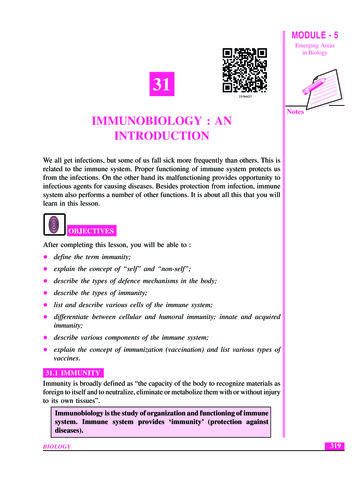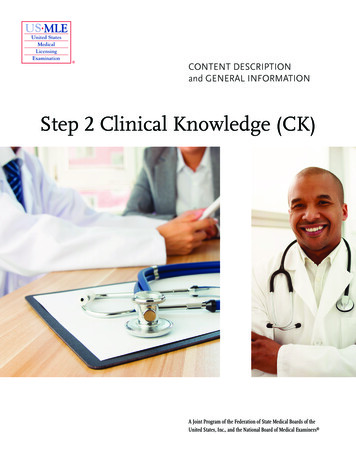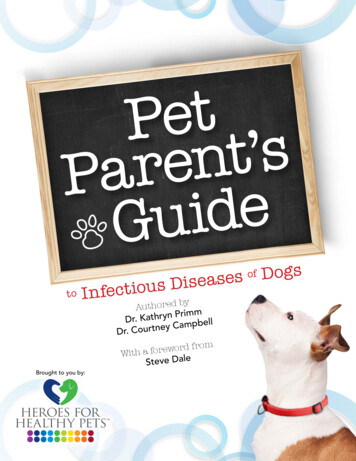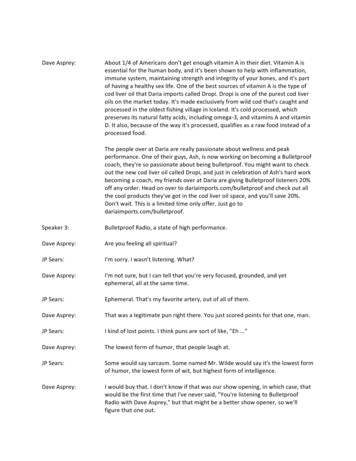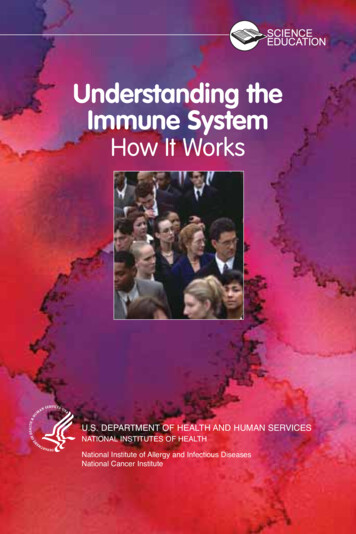
Transcription
Understanding theImmune SystemHow It WorksU.S. DEPARTMENT OF HEALTH AND HUMAN SERVICESNATIONAL INSTITUTES OF HEALTHNational Institute of Allergy and Infectious DiseasesNational Cancer Institute
Understanding theImmune SystemHow It WorksU.S. DEPARTMENT OF HEALTH AND HUMAN SERVICESNATIONAL INSTITUTES OF HEALTHNational Institute of Allergy and Infectious DiseasesNational Cancer InstituteNIH Publication No. 03-5423September 2003www.niaid.nih.govwww.nci.nih.gov
Contents1 Introduction2Self and Nonself3The Structure of the Immune System7 Immune Cells and Their Products19Mounting an Immune Response24Immunity: Natural and Acquired28Disorders of the Immune System34Immunology and Transplants36Immunity and Cancer39The Immune System and the Nervous System40Frontiers in Immunology45Summary47 Glossary
IntroductionTBacteria:streptococciVirus:herpes virusParasite:schistosomehe immune system is a network ofcells, tissues*, and organs that worktogether to defend the body against attacksby “foreign” invaders. These are primarilymicrobes (germs)—tiny, infection-causingorganisms such as bacteria, viruses,parasites, and fungi. Because the humanbody provides an ideal environment formany microbes, they try to break in. It isthe immune system’s job to keep them outor, failing that, to seek out and destroy them.When the immune system hits the wrongtarget or is crippled, however, it canunleash a torrent of diseases, includingallergy, arthritis, or AIDS.The immune system is amazingly complex.It can recognize and remember millions ofdifferent enemies, and it can producesecretions and cells to match up with andwipe out each one of them.The secret to its success is an elaborateand dynamic communications network.Millions and millions of cells, organizedinto sets and subsets, gather like clouds ofbees swarming around a hive and passinformation back and forth. Once immuneFungus:penicillium mold*Definitions of words printed in italics are listed in theGlossary on page 47.1
cells receive the alarm, they undergotactical changes and begin to producepowerful chemicals. These substancesallow the cells to regulate their owngrowth and behavior, enlist their fellows,and direct new recruits to trouble spots.Self and NonselfThe key to a healthy immune system isits remarkable ability to distinguishbetween the body’s own cells—self—andforeign cells—nonself. The body’s immunedefenses normally coexist peacefully withcells that carry distinctive “self” markermolecules. But when immune defendersencounter cells or organisms carryingAntigenMarker moleculeAntibodyAntigens carry marker molecules that identify themas foreign.2
markers that say “foreign,” they quicklylaunch an attack.Anything that can trigger this immuneresponse is called an antigen. An antigencan be a microbe such as a virus, or evena part of a microbe. Tissues or cells fromanother person (except an identical twin)also carry nonself markers and act asantigens. This explains why tissuetransplants may be rejected.In abnormal situations, the immune systemcan mistake self for nonself and launch anattack against the body’s own cells ortissues. The result is called an autoimmunedisease. Some forms of arthritis anddiabetes are autoimmune diseases. In othercases, the immune system responds to aseemingly harmless foreign substance suchas ragweed pollen. The result is allergy,and this kind of antigen is called an allergen.The Structure of the Immune SystemThe organs of the immune system arepositioned throughout the body. Theyare called lymphoid organs because theyare home to lymphocytes, small whiteblood cells that are the key players in theimmune system.3
Tonsils desLymphaticvesselsThe organs of the immune system are positionedthroughout the body.Bone marrow, the soft tissue in the hollowcenter of bones, is the ultimate source ofall blood cells, including white blood cellsdestined to become immune cells.The thymus is an organ that lies behindthe breastbone; lymphocytes known as4
Incominglymph aVeinArteryOutgoinglymph vesselThe lymph node contains numerous specializedstructures. T cells concentrate in the paracortex,B cells in and around the germinal centers, and plasmacells in the medulla.T lymphocytes, or just “T cells,” mature inthe thymus.Lymphocytes can travel throughout thebody using the blood vessels. The cells canalso travel through a system of lymphaticvessels that closely parallels the body’sveins and arteries. Cells and fluids areexchanged between blood and lymphaticvessels, enabling the lymphatic system tomonitor the body for invading microbes.The lymphatic vessels carry lymph, a clearfluid that bathes the body’s tissues.5
Small, bean-shaped lymph nodes are lacedalong the lymphatic vessels, with clustersin the neck, armpits, abdomen, and groin.Each lymph node contains specializedcompartments where immune cellscongregate, and where they canencounter antigens.Immune cells and foreign particles enterthe lymph nodes via incoming lymphaticvessels or the lymph nodes’ tiny bloodvessels. All lymphocytes exit lymph nodesthrough outgoing lymphatic vessels. Oncein the bloodstream, they are transported totissues throughout the body. They patroleverywhere for foreign antigens, thengradually drift back into the lymphaticsystem, to begin the cycle all over again.The spleen is a flattened organ at the upperleft of the abdomen. Like the lymph nodes,the spleen contains specializedcompartments where immune cells gatherand work, and serves as a meeting groundwhere immune defenses confront antigens.Clumps of lymphoid tissue are found inmany parts of the body, especially in thelinings of the digestive tract and theairways and lungs—territories that serve asgateways to the body. These tissues includethe tonsils, adenoids, and appendix.6
LymphnodeLymphaticvesselImmune cells and foreign particles enter the lymphnodes via incoming lymphatic vessels or the lymphnodes’ tiny blood vessels.Immune Cells and Their ProductsThe immune system stockpiles a hugearsenal of cells, not only lymphocytesbut also cell-devouring phagocytes andtheir relatives. Some immune cells take onall comers, while others are trained onhighly specific targets. To work effectively,most immune cells need the cooperation oftheir comrades. Sometimes immune cellscommunicate by direct physical contact,sometimes by releasing chemical messengers.The immune system stores just a few ofeach kind of the different cells needed torecognize millions of possible enemies.When an antigen appears, those fewmatching cells multiply into a full-scalearmy. After their job is done, they fade7
AntigenbindingsiteHeavychainLightchainVariable regionConstant regionAn antibody is madeup of two heavychains and two lightchains. The variableregion, which differsfrom one antibody tothe next, allows anantibody torecognize itsmatching antigen.away, leaving sentries behind to watch forfuture attacks.All immune cells begin as immature stemcells in the bone marrow. They respond todifferent cytokines and other signals togrow into specific immune cell types, suchas T cells, B cells, or phagocytes. Becausestem cells have not yet committed to aparticular future, they are an interestingpossibility for treating some immunesystem disorders. Researchers currently areinvestigating if a person’s own stem cellscan be used to regenerate damagedimmune responses in autoimmune diseasesand immune deficiency diseases.B LymphocytesB cells and T cells are the main typesof lymphocytes.B cells work chiefly by secretingsubstances called antibodies into thebody’s fluids. Antibodies ambush antigenscirculating the bloodstream. They arepowerless, however, to penetrate cells. Thejob of attacking target cells—either cellsthat have been infected by viruses or cellsthat have been distorted by cancer—is leftto T cells or other immune cells(described below).8
B cellPlasma cellAntibodyB cells mature into plasma cells that produce antibodies.Each B cell is programmed to make onespecific antibody. For example, one B cellwill make an antibody that blocks a virusthat causes the common cold, whileanother produces an antibody that attacksa bacterium that causes pneumonia.When a B cell encounters its triggeringantigen, it gives rise to many large cellsknown as plasma cells. Every plasma cellis essentially a factory for producing anantibody. Each of the plasma cellsdescended from a given B cellmanufactures millions of identicalantibody molecules and pours them intothe bloodstream.9
An antigen matches an antibody much as akey matches a lock. Some match exactly;others fit more like a skeleton key. Butwhenever antigen and antibody interlock,the antibody marks the antigenfor destruction.Antibodies belong to a family of largemolecules known as immunoglobulins.Different types play different roles in theimmune defense strategy. Immunoglobulin G, or IgG, worksefficiently to coat microbes, speedingtheir uptake by other cells in theimmune system. IgM is very effective at killing bacteria. IgA concentrates in body fluids—tears,saliva, the secretions of the respiratorytract and the digestive tract—guarding theentrances to the body. IgE, whose natural job probably is toprotect against parasitic infections, is thevillain responsible for the symptomsof allergy. IgD remains attached to B cells andplays a key role in initiating earlyB-cell response.Immunoglobulins10
T CellsUnlike B cells, T cells do not recognizefree-floating antigens. Rather, their surfacescontain specialized antibody-like receptorsthat see fragments of antigens on thesurfaces of infected or cancerous cells.T cells contribute to immune defenses intwo major ways: some direct and regulateimmune responses; others directly attackinfected or cancerous cells.Helper T cells, or Th cells, coordinateimmune responses by communicating withother cells. Some stimulate nearby B cellsto produce antibody, others call in microbegobbling cells called phagocytes, still othersactivate other T cells.Killer T cells—also called cytotoxic Tlymphocytes or CTLs—perform a differentfunction. These cells directly attack otherImmature T cellMature helperT cellMature cytotoxicT cellSome T cells are helper cells, others are killer cells.11
Killer cellTarget cellTarget-orientedgranulesSurface contactKiller cell makes contact with target cell, trains itsweapons on the target, then strikes.cells carrying certain foreign or abnormalmolecules on their surfaces. CTLs areespecially useful for attacking virusesbecause viruses often hide from other partsof the immune system while they growinside infected cells. CTLs recognize smallfragments of these viruses peeking outfrom the cell membrane and launch anattack to kill the cell.In most cases, T cells only recognize anantigen if it is carried on the surface of acell by one of the body’s own MHC, ormajor histocompatibility complex,molecules. MHC molecules are proteins12
recognized by T cells when distinguishingbetween self and nonself. A self MHCmolecule provides a recognizablescaffolding to present a foreign antigen tothe T cell.Although MHC molecules are required forT-cell responses against foreign invaders,they also pose a difficulty during organtransplantations. Virtually every cell in thebody is covered with MHC proteins, buteach person has a different set of theseproteins on his or her cells. If a T cellrecognizes a nonself MHC molecule onanother cell, it will destroy the cell.Therefore, doctors must match organrecipients with donors who have theclosest MHC makeup. Otherwise therecipient’s T cells will likely attackthe transplanted organ, leading tograft rejection.Natural killer (NK) cells are another kindof lethal white cell, or lymphocyte. Likekiller T cells, NK cells are armed withgranules filled with potent chemicals.But while killer T cells look for antigenfragments bound to self-MHC molecules,NK cells recognize cells lacking self-MHCmolecules. Thus NK cells have thepotential to attack many types offoreign cells.13
MonocyteEosinophilMast cellMacrophageNeutrophilBasophilPhagocytes, granulocytes, and mast cells, all withdifferent methods of attack, demonstrate the immunesystem’s versatility.Both kinds of killer cells slay on contact.The deadly assassins bind to their targets,aim their weapons, and then deliver alethal burst of chemicals.Phagocytes and Their RelativesPhagocytes are large white cells that canswallow and digest microbes and otherforeign particles. Monocytes arephagocytes that circulate in the blood.When monocytes migrate into tissues,they develop into macrophages.Specialized types of macrophages can befound in many organs, including lungs,kidneys, brain, and liver.14
Macrophages play many roles. Asscavengers, they rid the body of worn-outcells and other debris. They display bitsof foreign antigen in a way that draws theattention of matching lymphocytes. Andthey churn out an amazing variety ofpowerful chemical signals, knownas monokines, which are vital to theimmune responses.Granulocytes are another kind of immunecell. They contain granules filled withpotent chemicals, which allow thegranulocytes to destroy microorganisms.Some of these chemicals, such ashistamine, also contribute to inflammationand allergy.One type of granulocyte, the neutrophil, isalso a phagocyte; it uses its prepackagedchemicals to break down the microbes itingests. Eosinophils and basophils aregranulocytes that “degranulate,” sprayingtheir chemicals onto harmful cells ormicrobes nearby.The mast cell is a twin of the basophil,except that it is not a blood cell. Rather, itis found in the lungs, skin, tongue, andlinings of the nose and intestinal tract,where it is responsible for the symptomsof allergy.A related structure, the blood platelet, is acell fragment. Platelets, too, contain15
granules. In addition to promoting bloodclotting and wound repair, plateletsactivate some of the immune defenses.CytokinesComponents of the immune systemcommunicate with one another byexchanging chemical messengers calledcytokines. These proteins are secreted bycells and act on other cells to coordinate anappropriate immune response. Cytokinesinclude a diverse assortment of interleukins,interferons, and growth factors.Some cytokines are chemical switches thatturn certain immune cell types on and off.One cytokine, interleukin 2 (IL-2), triggersthe immune system to produce T cells. IL2’s immunity-boosting properties havetraditionally made it a promising treatmentfor several illnesses. Clinical studies areongoing to test its benefits in otherdiseases such as cancer, hepatitis C, andCytokines includelymphokines,produced bylymphocytes, andmonokines, madeby monocytes andmacrophages.LymphokinesMature helper T cell16MonokinesMacrophage
HIV infection and AIDS. Other cytokinesalso are being studied for their potentialclinical benefit.Other cytokines chemically attract specificcell types. These so-called chemokines arereleased by cells at a site of injury orinfection and call other immune cells tothe region to help repair the damage orfight off the invader. Chemokines oftenplay a key role in inflammation and area promising target for new drugs to helpregulate immune responses.ComplementThe complement system is made up ofabout 25 proteins that work together to“complement” the action of antibodies indestroying bacteria. Complement also helpsto rid the body of antibody-coated antigens(antigen-antibody complexes). Complementproteins, which cause blood vessels tobecome dilated and then leaky, contributeto the redness, warmth, swelling, pain, andloss of function that characterize aninflammatory response.Complement proteins circulate in the bloodin an inactive form. When the first proteinin the complement series is activated—typically by antibody that has locked ontoan antigen—it sets in motion a dominoeffect. Each component takes its turn in aprecise chain of steps known as thecomplement cascade. The end product is a17
AntigenFirst complement proteinAntibody (IgG)Complement cascadeCellswellsandburstsCylindrical complexinserted in cell wallThe interlocking steps of the complement cascade end incell death.cylinder inserted into—and puncturing ahole in—the cell’s wall. With fluids andmolecules flowing in and out, the cellswells and bursts. Other components of thecomplement system make bacteria moresusceptible to phagocytosis or beckon othercells to the area.18
Mounting an Immune ResponseInfections are the most common cause ofhuman disease. They range from thecommon cold to debilitating conditions likechronic hepatitis to life-threateningdiseases such as AIDS. Disease-causingmicrobes (pathogens) attempting to getinto the body must first move past thebody’s external armor, usually the skin orcells lining the body’s internal passageways.The skin provides an imposing barrier toinvading microbes. It is generallypenetrable only through cuts or tinyabrasions. The digestive and respiratoryLymphokinesComplementT cellAntibodiesB cellMacrophageKiller cellVirusWhen challenged, the immune system has manyweapons to choose.19
tracts—both portals of entry for a numberof microbes—also have their own levels ofprotection. Microbes entering the noseoften cause the nasal surfaces to secretemore protective mucus, and attempts toenter the nose or lungs can trigger asneeze or cough reflex to force microbialinvaders out of the respiratorypassageways. The stomach contains astrong acid that destroys many pathogensthat are swallowed with food.If microbes survive the body’s front-linedefenses, they still have to find a waythrough the walls of the digestive,respiratory, or urogenital passageways tothe underlying cells. These passagewaysare lined with tightly packed epithelial cellscovered in a layer of mucus, effectivelyblocking the transport of many organisms.Mucosal surfaces also secrete a specialclass of antibody called IgA, which inmany cases is the first type of antibody toencounter an invading microbe.Underneath the epithelial layer a numberof cells, including macrophages, B cells,and T cells, lie in wait for any germ thatmight bypass the barriers at the surface.Next, invaders must escape a series ofgeneral defenses, which are ready toattack, without regard for specific antigenmarkers. These include patrollingphagocytes, NK cells, and complement.20
Microbes that cross the general barriersthen confront specific weapons tailoredjust for them. Specific weapons, whichinclude both antibodies and T cells, areequipped with singular receptor structuresthat allow them to recognize and interactwith their designated targets.Bacteria, Viruses, and ParasitesThe most common disease-causingmicrobes are bacteria, viruses, andparasites. Each uses a different tactic toinfect a person, and, therefore, each isthwarted by a different part of theimmune system.Most bacteria live in the spaces betweencells and are readily attacked byantibodies. When antibodies attach to abacterium, they send signals tocomplement proteins and phagocytic cellsto destroy the bound microbes. Somebacteria are eaten directly by phagocytes,which signal to certain T cells to jointhe attack.All viruses, plus a few types of bacteriaand parasites, must enter cells to survive,requiring a different approach. Infectedcells use their MHC molecules to putpieces of the invading microbes on thecell’s surface, flagging down cytotoxicT lymphocytes to destroy the infected cell.Antibodies also can assist in the immune21
Antibodies are triggered when a B cellencounters its matching antigen.The B cell takes in the antigenand digests it,then it displays antigen fragmentsbound to its own distinctiveMHC molecules.The combination of antigenfragment and MHCmolecule attractsthe help of amature, matchingT cell.Lymphokines secreted bythe T cell allow the B cell tomultiply and mature intoantibody-producing plasma cells.Released into the bloodstream, antibodies lock ontomatching antigens. These antigen-antibody complexesare soon eliminated, either by the complement cascadeor by the liver and the spleen.22
T cells are mobilizedwhen they encounter a cell such as a macrophageor a B cell that has digested an antigenand is displaying antigen fragmentsbound to its MHC molecules.Lymphokineshelp the T cellto matureThe T cell, alertedand activated,secreteslymphokines.InfectedcellsSome lymphokinesattract immune cells—fresh macrophages,granulocytes, andother lymphocytes—to the site of infection.Yet other lymphokinesdirect the recruits oncethey arrive on the scene.Somelymphokinesspur thegrowth ofmore T cells.Some T cellsbecome killer cellsand track downbody cells infectedby viruses.23
response, attaching to and clearing virusesbefore they have a chance to enter the cell.Parasites live either inside or outside cells.Intracellular parasites such as the organismthat causes malaria can trigger T-cellresponses. Extracellular parasites are oftenmuch larger than bacteria or viruses andrequire a much broader immune attack.Parasitic infections often trigger aninflammatory response when eosinophils,basophils, and other specialized granularcells rush to the scene and release theirstores of toxic chemicals in an attempt todestroy the invader. Antibodies also play arole in this attack, attracting the granularcells to the site of infection.Immunity: Natural and AcquiredLong ago, physicians realized that peoplewho had recovered from the plague wouldnever get it again—they had acquiredimmunity. This is because some of theactivated T and B cells become memory cells.The next time an individual meets up withthe same antigen, the immune system isset to demolish it.Immunity can be strong or weak, shortlived or long-lasting, depending on the typeof antigen, the amount of antigen, and theroute by which it enters the body.24
AntigenNaturalNaturalS E RU MAcquiredAcquiredImmunity can also be influenced byinherited genes. When faced with the sameantigen, some individuals will respondforcefully, others feebly, and some not at all.An immune response can be sparked notonly by infection but also by immunizationwith vaccines. Vaccines containmicroorganisms—or parts ofmicroorganisms—that have been treated sothey can provoke an immune response butnot full-blown disease.Immunity can also be transferred from oneindividual to another by injections ofserum rich in antibodies against aparticular microbe (antiserum).25
For example, immune serum is sometimesgiven to protect travelers to countrieswhere hepatitis A is widespread. Suchpassive immunity typically lasts only a fewweeks or months.Infants are born with weak immuneresponses but are protected for the first fewmonths of life by antibodies received fromtheir mothers before birth. Babies who arenursed can also receive some antibodiesfrom breast milk that help to protect theirdigestive tracts.Immune ToleranceImmune tolerance is the tendency of T orB lymphocytes to ignore the body’s owntissues. Maintaining tolerance is importantbecause it prevents the immune systemfrom attacking its fellow cells. Scientistsare hard at work trying to understand howthe immune system knows when torespond and when to ignore.Tolerance occurs in at least two ways.Central tolerance occurs during lymphocytedevelopment. Very early in each immunecell’s life, it is exposed to many of the selfmolecules in the body. If it encountersthese molecules before it has fullymatured, the encounter activates aninternal self-destruct pathway and theimmune cell dies. This process, called26
clonal deletion, helps ensure that selfreactive T cells and B cells do not matureand attack healthy tissues.Because maturing lymphocytes do notencounter every molecule in the body, theymust also learn to ignore mature cells andtissues. In peripheral tolerance, circulatinglymphocytes might recognize a selfmolecule but cannot respond because someof the chemical signals required to activatethe T or B cell are absent. So-called clonalanergy, therefore, keeps potentially harmfullymphocytes switched off. Peripheraltolerance may also be imposed by a specialclass of regulatory T cells that inhibitshelper or cytotoxic T-cell activation byself antigens.VaccinesMedical workers have long helped thebody’s immune system prepare for futureattacks through vaccination. Vaccinesconsist of killed or modified microbes,components of microbes, or microbial DNAthat trick the body into thinking aninfection has occurred. An immunizedperson’s immune system attacks theharmless vaccine and prepares forsubsequent invasions. Vaccines remain oneof the best ways to prevent infectiousdiseases and have an excellent safetyrecord. Previously devastating diseasessuch as smallpox, polio, and whooping27
cough have been greatly controlled oreliminated through worldwidevaccination programs.Disorders of the Immune SystemAllergic DiseasesThe most common types of allergicdiseases occur when the immune systemresponds to a false alarm. In an allergicperson, a normally harmless material suchas grass pollen or house dust is mistakenfor a threat and attacked.Allergies such as pollen allergy are relatedto the antibody known as IgE. Like otherantibodies, each IgE antibody is specific;one acts against oak pollen, anotheragainst ragweed.Autoimmune DiseasesSometimes the immune system’srecognition apparatus breaks down, andthe body begins to manufacture T cells andantibodies directed against its own cellsand organs. Misguided T cells andautoantibodies, as they are known,contribute to many diseases. For instance,T cells that attack pancreas cells contributeto diabetes, while an autoantibody knownas rheumatoid factor is common in peoplewith rheumatoid arthritis. People withsystemic lupus erythematosus (SLE) have28
RagweedpollenB cellThe first time the allergy-proneperson runs across an allergensuch as ragweed,IgEhe or she makes large amountsof ragweed IgE antibody.PlasmacellThese IgE molecules attachthemselves to mast cells.MastcellThe second time that personhas a brush with ragweed,the IgE-primed mast cell willrelease its powerful chemicals,ChemicalsSymptomsand the person will suffer thewheezing and/or sneezing,runny nose, watery eyes, anditching of allergy.29
PancreasMature T cellBeta cellMisguided T cells can attack insulin-producing cells ofthe pancreas, contributing to diabetes.antibodies to many types of their own cellsand cell components.No one knows exactly what causes anautoimmune disease, but multiple factorsare likely to be involved. These includeelements in the environment, such asviruses, certain drugs, and sunlight, all ofwhich may damage or alter normal bodycells. Hormones are suspected of playing arole, since most autoimmune diseases arefar more common in women than in men.Heredity, too, seems to be important.Many people with autoimmune diseaseshave characteristic types of selfmarker molecules.30
Immune Complex DiseasesImmune complexes are clusters ofinterlocking antigens and antibodies.Normally, immune complexes are rapidlyremoved from the bloodstream. Sometimes,however, they continue to circulate, andeventually become trapped in the tissues ofthe kidneys, the lungs, skin, joints, orblood vessels. There they set off reactionswith complement that lead to inflammationand tissue damage.Immune complexes work their mischief inmany diseases. These include malaria andviral hepatitis, as well as manyautoimmune diseases.LargecomplexEndothelial cellGlomerular basementmembrane of kidneySmall complexAntigen-antibody complexes can become trapped in,and damage, the kidneys and other organs.31
Immunodeficiency DisordersWhen the immune system is missing oneor more of its components, the result is animmunodeficiency disorder.Immunodeficiency disorders can beinherited, acquired through infection, orproduced unintentionally by drugs such asthose used to treat people with cancer orthose who have received transplants.Temporary immune deficiencies candevelop in the wake of common virusinfections, including influenza, infectiousmononucleosis, and measles. Immuneresponses can also be depressed by bloodtransfusions, surgery, malnutrition,smoking, and stress.Some children are born with poorlyfunctioning immune systems. Some haveflaws in the B cell system and cannotproduce antibodies. Others, whose thymusis either missing or small and abnormal,lack T cells. Very rarely, infants are bornlacking all of the major immune defenses.This condition is known as severe combinedimmunodeficiency disease or SCID.AIDS is an immunodeficiency disordercaused by a virus (HIV) that infectsimmune cells. HIV can destroy or disablevital T cells, paving the way for a varietyof immunologic shortcomings. HIV alsocan hide out for long periods in immune32
Virus componentsVirus DNAT cellNewvirusCell DNANew AIDSvirus buddingfrom T cellThe AIDS virus takes over the machinery of the T cells itinfects, using it to make new viruses.cells. As the immune defenses falter, aperson with AIDS falls prey to unusual,often life-threatening infections andrare cancers.A contagious disease, AIDS is spread byintimate sexual contact, transfer of thevirus from mother to infant duringpregnancy, or direct blood contamination.There is no cure for AIDS, but newlydeveloped antiviral drugs can slow theadvance of the disease, at least for a time.Researchers also are testing HIV vaccinesin clinical studies.33
Cancers of the Immune SystemThe cells of the immune system, like othercells, can grow uncontrollably, resulting incancer. Leukemias are caused by theproliferation of white blood cells, orleukocytes. The uncontrolled growth ofantibody-producing plasma cells can leadto multiple myeloma. Cancers of thelymphoid organs, known as lymphomas,include Hodgkin’s disease.Immunology and TransplantsEach year thousands of American lives areprolonged by transplanted organs—kidney, heart, lung, liver, and pancreas. Fora transplant to “take,” however, the body’snatural tendency to rid itself o
gradually drift back into the lymphatic system, to begin the cycle all over again. The spleen is a flattened organ at the upper left of the abdomen. Like the lymph nodes, the spleen contains specialized compartments where immune cells gather and work, and serves as

